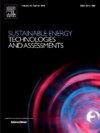Size optimization of the PV-wind complementary pumping station system considering water supply and power reduction
IF 7.1
2区 工程技术
Q1 ENERGY & FUELS
Sustainable Energy Technologies and Assessments
Pub Date : 2025-07-04
DOI:10.1016/j.seta.2025.104440
引用次数: 0
Abstract
Determining the optimal energy mix and system size is a critical technological challenge in the design of photovoltaic (PV)-wind hybrid energy pumping station systems around the world. This study proposed a framework for optimizing the PV-wind pumping station system size while considering water supply and power reduction. Firstly, the composition and operation principle of the PV-wind pumping station system were presented. Then, a dual-objective model was proposed to optimize the PV-wind capacity proportion. A size optimization model was established to maximize pumping flow and minimize power reduction rate. Finally, the proposed method was tested using the China Lijiazhuang pumping station. The results displayed that the optimal capacity proportion of PV and wind was 0.324 and 0.676, respectively. Additionally, as the PV/wind size increases, the annual average pumping flow gradually increases, while the annual new energy power reduction rate initially decreases and then increases. The primary causes of electricity loss are PV/wind output falling below the pumping station’s minimum power requirement and PV/wind output exceeding the pumping station’s actual consumption capacity. Consequently, these findings offer valuable guidance for the development of global renewable energy and the implementation of new energy pumping station systems in various regions.
考虑供水和节能的PV-wind互补泵站系统规模优化
确定最佳的能源结构和系统规模是世界范围内光伏-风能混合能源泵站系统设计中的一个关键技术挑战。本研究提出了在考虑供水和节能的情况下优化PV-wind泵站系统规模的框架。首先介绍了光伏-风力泵站系统的组成和工作原理。在此基础上,提出了优化光伏-风电容量比例的双目标模型。以泵送流量最大、功率降低率最小为目标,建立了尺寸优化模型。最后,以中国李家庄泵站为例对该方法进行了验证。结果表明,光伏和风能的最优容量比例分别为0.324和0.676。此外,随着光伏/风电装机容量的增加,年平均抽气量逐渐增加,年新能源减功率率先减小后增大。造成电力损失的主要原因是光伏/风力发电量低于泵站的最低电力需求,以及光伏/风力发电量超过泵站的实际消费能力。因此,这些研究结果对全球可再生能源的发展和新能源泵站系统在各地区的实施具有重要的指导意义。
本文章由计算机程序翻译,如有差异,请以英文原文为准。
求助全文
约1分钟内获得全文
求助全文
来源期刊

Sustainable Energy Technologies and Assessments
Energy-Renewable Energy, Sustainability and the Environment
CiteScore
12.70
自引率
12.50%
发文量
1091
期刊介绍:
Encouraging a transition to a sustainable energy future is imperative for our world. Technologies that enable this shift in various sectors like transportation, heating, and power systems are of utmost importance. Sustainable Energy Technologies and Assessments welcomes papers focusing on a range of aspects and levels of technological advancements in energy generation and utilization. The aim is to reduce the negative environmental impact associated with energy production and consumption, spanning from laboratory experiments to real-world applications in the commercial sector.
 求助内容:
求助内容: 应助结果提醒方式:
应助结果提醒方式:


